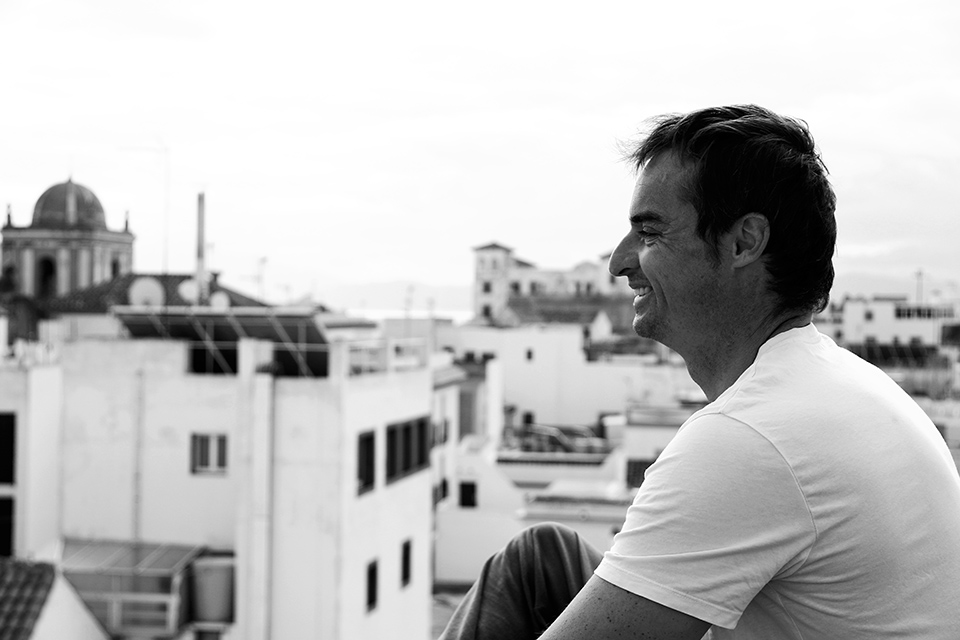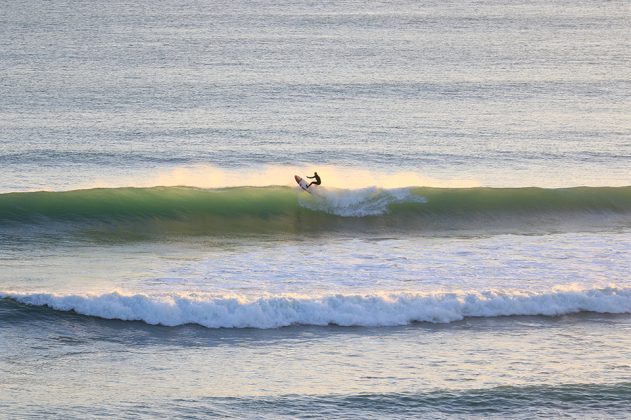BLOW IN: TARIFA
ANDALUSIA
With – Fred Bonnef Photos – Carole Farnon
Tarifa is a renowned spot for both the practising windsports and the insomnious celebrations thereof, but the potential of Andalusia is unrecognized for stand up paddling. Whether it’s for surfing, cruising or for nuking downwinders, this part of southern Spain has that much to offer you’ll be paddling out so early you’ll pass the poledancers as they stagger home from La Ruina.
I first came to Tarifa in 2001, dividing my time between windsurfing competitions, surf, work, parties and friends. I’ve spent a lot of time there but also travelled to a lot of magical places and lived in the Canary Islands and the Baque country for a while. However, Andalusia is the only place where I really feel I am at home; even more than in France, my own country. There’s a kind of magic here. But I am not a travel agent and I wrote this guide with only one goal: for you to go and paddle there!
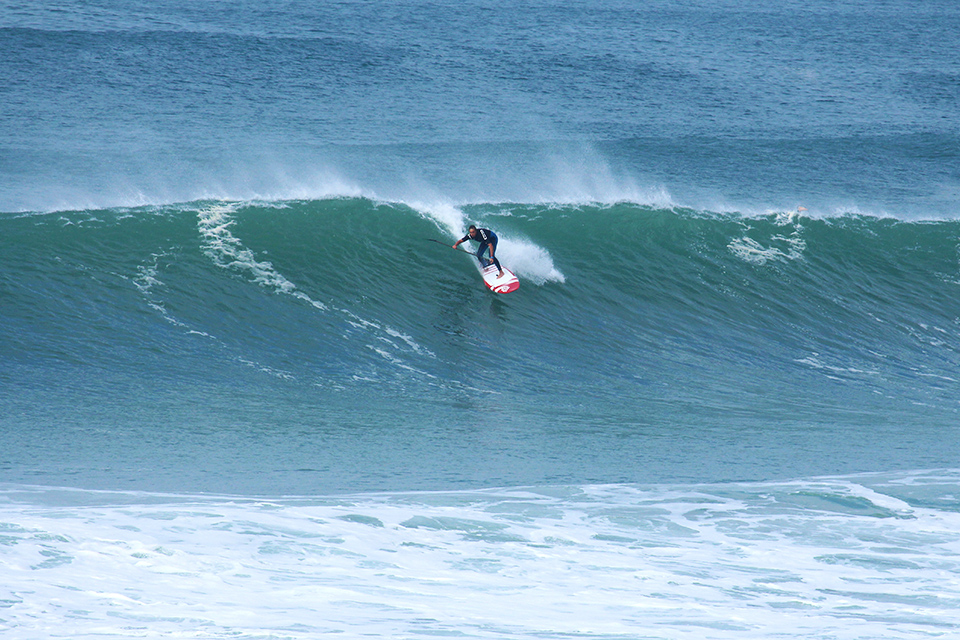
SURFING
Yes, there are some good waves in Andalusia, but you have to be there at the right time and you have to know where to go. Obviously, you have to deal with the wind as you cruise along the coast looking for waves, however, some spots are shletered from the wind depending on where it’s blowing from. Here are a few examples, but other spots can be found if you search a little bit more…
Tarifa Balneario (village): works with light Levante (east) and Atlantic swell.
Fast beachbreak can be OK even for beginners when it’s small, but can also be very technical and powerful during big wintertime swells. If you are staying in Tarifa, this is the first spot to check to get an overview of the swell size and wind direction. Keep in mind that it can be twice as big around El Palmar and Canos de Meca.
It’s also a good opportunity to see what’s going on in the Med, just by looking over the seawall.
Tarifa Arte Vida (mid bay): also works with light Levante and Atlantic swell. Easy spot for all levels, sandy beach with a family atmosphere. Unfortunately, it does not work that much.
Tarifa Benavides (dunes area): works with north west wind and Atlantic swell. Quite an easy spot, but beware of the rocks. A good option when there is a big swell and north west wind as it the spot is then sheltered from the wind. The wave can be quite long.
Bolonia: go here on an Atlantic swell and no wind.
A beautiful sandy beach, cool atmosphere, a few rocks, and some cows. There is usually a bit more swell in this bay than at Tarifa.
Zahara de los Atunes: you guessed it, works with Atlantic swell and no wind.
Sandy beachbreak, whether good or mushy. The big plus is that it’s never crowded and there is a lot of space.
Canos de Meca: works with Poniente (west) or very light Levante or North West wind, and Atlantic swell.
The spots around Canos can be really good, but it is often crowded. Less problematic if you stay on the right hand side of the bay (towards the lighthouse) where a nice right breaks when the swell is on. Very popular with sup surfers and longboarders. A little further on there is a more powerful lefthander, approach with etiquette.
El Palmar: works with light Levante and Atlantic swell.
There is always more swell hitting this spot and most of the local surf activity is concentrated here with surfschools and rentals. Nevertheless, there is always space for everybody thanks to many different peaks. Be respectful towards the local surfers, do not paddle for every wave you see as the level is pretty high here. The beach is wide, look for an empty peak.
Getares (Mediterranean): works with Mediterranean swell and no wind.
The landscape is pretty grim here. Getares is an urban spot with a views towards Algeciras and Gibraltar. Nevertheless, this spotis close by and can be a good alternative in case of a Mediterranean swell and there’s plenty of space.
Cabopino (Mediterranean): a bit of a drive (60 miles). Works with very light Poniente or no wind, and Mediterranean swell.
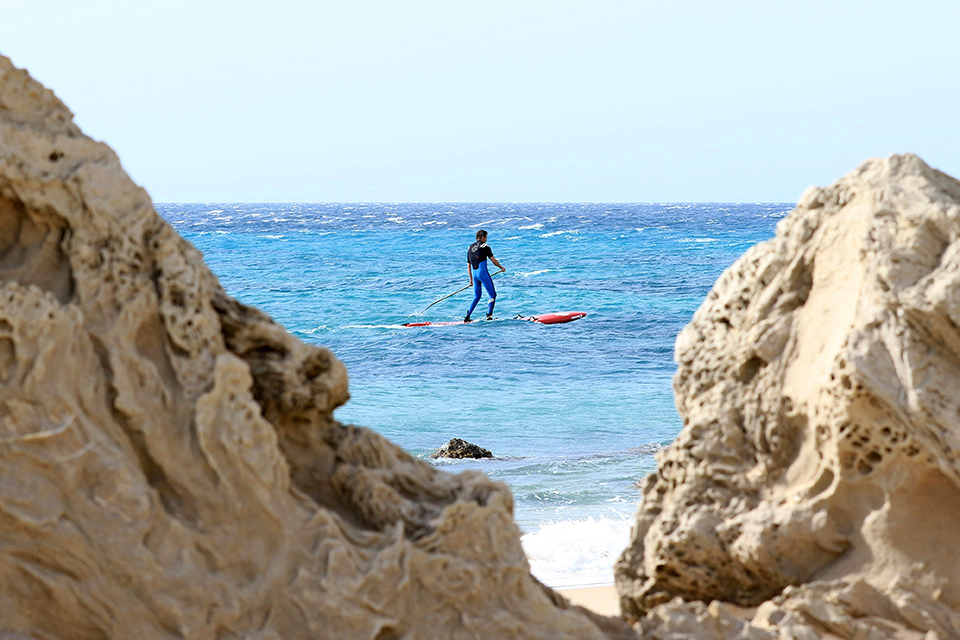
DOWNWIND
Caution is paramount when considering a downwinder in this area. You don’t mess with the Strait of Gibraltar. Why? Firstly because the winds can be very strong, often offshore and if you don’t properly calculate your trajectory you can quickly find yourself in big trouble. If it goes wrong in a strong Levante, hopefully you have anticipated everything and planned your escape routes, or you are miraculously rescued by a super tanker assuming it does not run over you, or you go straight to Brazil. Maybe Madeira if you are lucky.
Secondly, because the winds are pretty unpredictable and can increase or decrease sifnificantly, especially as they are augmented by thermal, katabatic and venturi effects.
Around Tarifa, the meeting of waters of the Mediterranean and the Atlantic create extremely strong currents so you have to consider the tide times as you plan your route.
The sea traffic is unceasing as the Strait of Gibraltar is the second busiest seaway in the world with more than 100,000 boats a year. Needless to say it is difficult to slow down a super tanker or a ferry at full speed and it’s better not being in their way in the first place.
So it’s important to observe the conditions, be well prepared with all the safety equipment (including signal flares and flashlight), don’t go alone and avail of safety cover on land or even better, on the water.
Once these considerations are in mind, the Strait of Gibraltar and its surroundings offer one of the best playgrounds in Europe, if not in the world. The wind statistics are among the best in the world and the bumps are sublime. The two prevailing winds, Levante and Poniente, offer incredible downwinders. The scenery is breathtaking with Africa on one side and the Andalusian coast to the other. The beautiful beaches of the Atlantic coast offer many access points with very little shore break to negotiate.
Levante wind
The shortest and safest trip is to launch from Arte Vida beach with an arrival at Las Dunas – about 5 miles. Do not start from the town of Tarifa if you are not an experienced, strong paddler because the side from Balneario to Dos Mares will push you out to sea. It’s navigable in a canoe or surf ski, but harder on a SUP.
A little bit of a longer trip that I particularly like on Levante wind is Arte Vida to Bolonia. It’s about 9 miles and there are great bumps off Punta Paloma, and the environment is magical on the wild coast run down to Bolonia with many opportunities to have a breather along the way.
Poniente wind
The possibilities are also very interesting coming back in the other direction from the points of Bolonia or Punta Paloma, and on to Tarifa.
For experienced downwind paddlers, there are also some opportunities up to Getares in the Strait, but remember the considerations above.
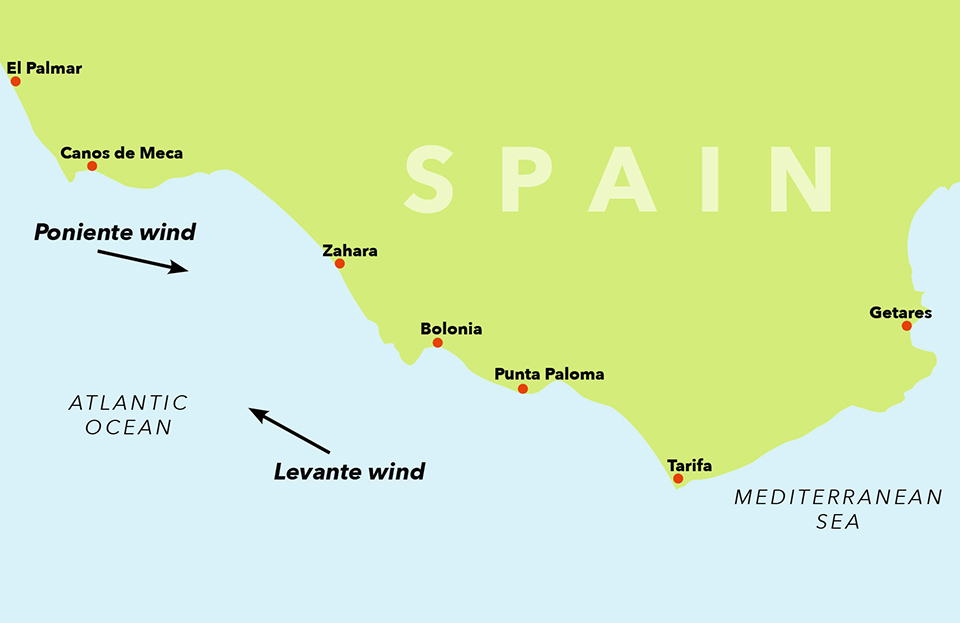
CRUISING
There are countless opportunities to go cruising if there is no wind, but you have to be very attentive to the weather, and keep in mind that the wind can quickly increase. So do not stray away from the coast and avoid offshore wind areas.
Bolonia’s bay is large and beautiful. There is much to see around the east and west points and you won’t be bothered by anybody.
The area by the dune around Punta Paloma is also beautiful and is well protected from the Poniente.
The area between the Hotel Hurricane and Valdevaqueros is worth a visit, with some beautiful hidden places around “Balcon de Espana”.
When there is no Levante, neither expected nor apparent, go to the “La Caleta” area on the East side of the harbour. It’s a beautiful place with steep cliffs that fall into the sea and a great view over to Morocco. SUP
